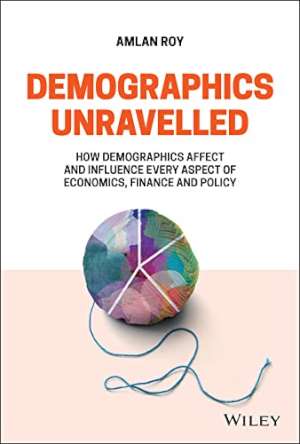26 July 2023
Demographics Unravelled
How Demographics Affect and Influence Every Aspect of Economics, Finance and Policy
Amlan Roy
2022, John Wiley and Sons, 320 pages,
ISBN 9781119799139
Reviewer: William A Allen, NIESR

Amlan Roy’s purpose in this book is to identify the effects of demographic changes, past and expected future, on a wide range of social issues, such as macro-economics (growth, inflation, debt sustainability), asset prices, health and longevity, pensions and quality of life. It contains no original work but draws on an impressively wide range of work by others on these various subjects. The projections of the United Nations make it clear that demographic changes have affected and will continue to affect more or less every aspect of social and economic life: to give just one example, the increasing percentage of the population accounted for by retired people is certain to have profound effects on social attitudes and public finances.
It is therefore a great pity that Roy doesn’t write very well (and a bit of a surprise, in the light of the seventeen celebrity endorsements at the beginning of the book). It is hard to work out what some of his sentences mean, others of them are trite (‘people are at the core of any economy’), the text and the tables are inconsistent in places, the lines in many of the figures are indistinguishable, the author inserts his personal opinions rather too often for my taste, and his accounts of the works of others on the various issues are lists rather than syntheses. The book seems to have been written in a hurry and not edited very carefully.
Although the author is evidently well-read, there are some important issues that he doesn’t explore fully. One is Malthusianism. He cites Malthus’ famous work of 1798, which predicted that increases in food supply would be matched by increases in population, so that food supply per capita would remain unchanged. He neglects to mention that Malthus has been proved wrong by events: since 1961, world gross food production per capita has increased by 48%, according to the UN Food and Agriculture Organisation. Population growth in richer countries has slowed down as increasing wealth appears to have led to lower desire to reproduce, contrary to Malthus’ prediction, and world population growth has been falling.
A related issue is the projected disparity among population growth rates: the populations of richer countries are expected to fall between now and 2100, whereas those of poorer countries are expected to go on increasing. If the poor countries don’t get richer, and the rich countries don’t get poorer, migration pressures will surely increase. Roy discusses migration, and makes the useful point that migration experiences differ greatly among rich countries, e.g. Germany and Japan. But he doesn’t reach any general conclusion other than the anodyne ‘it is a complex, sensitive issue and a function of attitudes, political party views, skills gaps, extent of openness and the degree of globalisation or regionalisation.’ The tensions will have to be resolved one way or another, and it is frustrating that Roy ducks the question of how that might happen.
I suspect that Roy set himself an impossible task. Demographic effects are so pervasive that a comprehensive account of them would logically require a comprehensive account of social and economic life around the world. That would be well beyond the capacity of any author, or any book.
